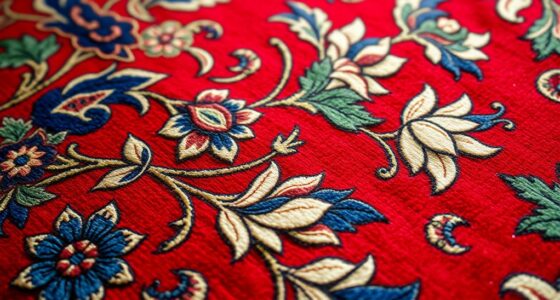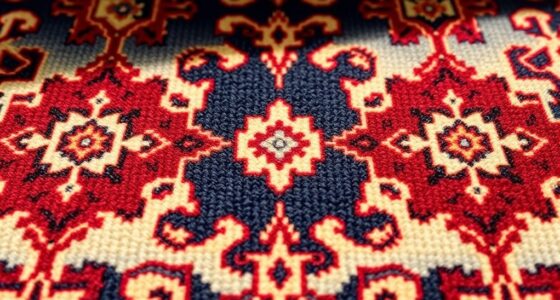Wool rugs naturally resist stains thanks to lanolin, a fatty substance that coats wool fibers with a water-repellent layer. This layer is made of long-chain fatty acids, alcohols, and esters that form a tight, hydrophobic barrier, causing liquids to bead up and roll off. Lanolin’s molecular structure repels water and other spills, helping keep your rug clean. Keep watching, and you’ll discover the science behind lanolin’s remarkable protective qualities in your wool rug.
Key Takeaways
- Lanolin’s long-chain fatty acids form a hydrophobic barrier that repels water and stains on wool fibers.
- Molecular structure of lanolin causes liquids to bead up, minimizing contact and preventing absorption.
- Regular vacuuming maintains lanolin’s protective layer, preserving wool’s natural stain resistance.
- Lanolin’s composition enhances wool’s water-repellent and dirt-resistant properties, reducing stain likelihood.
- Proper cleaning and spill management prevent damage to lanolin’s protective coating, sustaining wool’s stain resistance.
The Chemistry Behind Lanolin’s Protective Layer
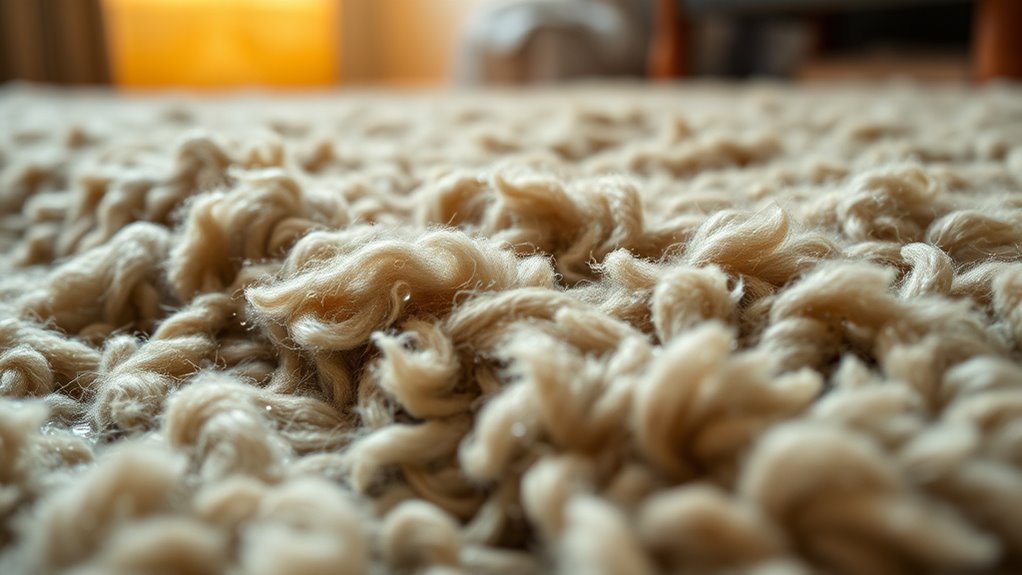
Lanolin’s protective layer is primarily due to its unique chemical composition, which consists mainly of long-chain fatty acids, alcohols, and esters. These molecules create a dense, water-resistant barrier on wool fibers, preventing liquids from penetrating easily. The fatty acids contribute to the hydrophobic nature, repelling water and moisture. Alcohols and esters enhance the stability and flexibility of the layer, allowing it to adhere tightly to the wool surface. When you observe wool rugs with natural stain resistance, it’s this complex chemical makeup that offers protection. The structure of these compounds forms a cohesive, lipid-like coating that keeps liquids and dirt from soaking into the fibers. This natural barrier is key to lanolin’s effectiveness in maintaining the wool’s durability and cleanliness. Additionally, the presence of these lipid-like substances influences the overall chemical stability of the wool fibers, further supporting their resistance to stains and environmental damage.
How Lanolin Repels Liquids at the Molecular Level
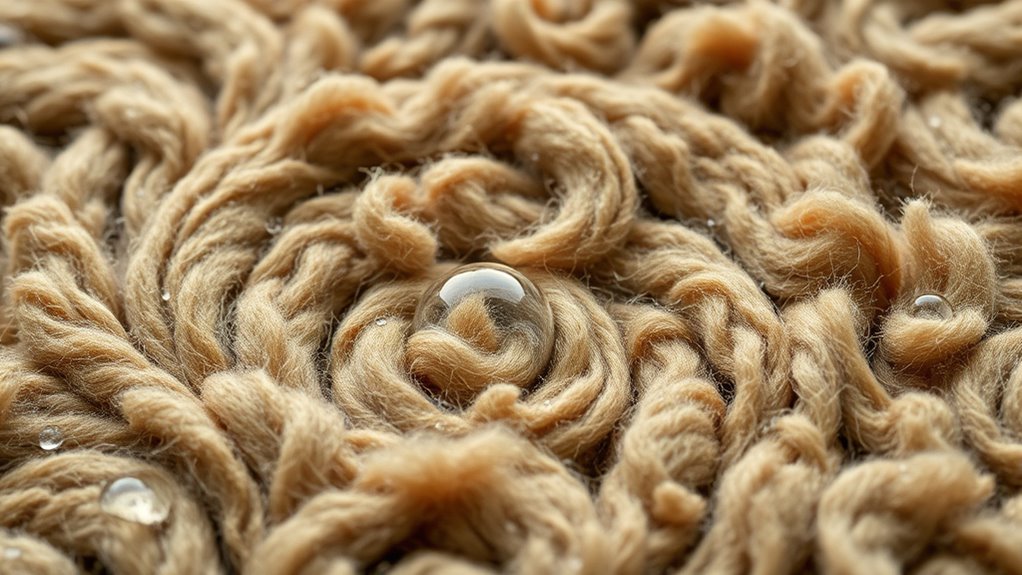
At the molecular level, lanolin’s ability to repel liquids hinges on its composition of long-chain fatty acids and alcohols, which arrange themselves into a tightly packed, hydrophobic barrier on wool fibers. These molecules have nonpolar tails, making them resistant to water and other polar liquids. When a droplet contacts the wool surface, the hydrophobic barrier prevents the liquid from spreading or penetrating. Instead, the liquid beads up, minimizing contact with the fibers. This effect occurs because water molecules prefer to stick to each other rather than interact with the nonpolar lanolin layer. The result is that liquids are naturally repelled, reducing staining and allowing spills to be easily wiped away. This molecular arrangement provides wool with its impressive, natural resistance to liquids. Additionally, understanding the molecular structure of lanolin helps explain its effectiveness in creating a protective barrier.
Historical Uses of Wool and Lanolin’s Natural Benefits

Throughout history, wool has been valued not only for its warmth and durability but also for the natural benefits provided by lanolin. Ancient civilizations used wool for clothing, bedding, and trade, recognizing its resilience and insulating properties. Lanolin, a natural wax in wool, helped protect fibers from moisture and dirt, reducing the need for frequent cleaning. This protection was especially beneficial in harsh climates, making wool a trusted material worldwide. Wool’s ability to resist stains and repel liquids stems from lanolin’s natural properties, which have been utilized for centuries. The water-repellent qualities of lanolin contributed to the longevity of wool products in various environments. The table below highlights key historical uses and benefits:
| Use | Benefit |
|---|---|
| Clothing | Water resistance and durability |
| Bedding | Insulation and moisture protection |
| Trade goods | Longevity and stain resistance |
| Medicinal applications | Skin protection and healing |
Comparing Wool Rugs to Synthetic Alternatives

When choosing a rug, comparing wool to synthetic alternatives reveals significant differences in durability, appearance, and environmental impact. Wool rugs are naturally resilient, resisting crushing and matting, and they tend to age gracefully over time. Their rich texture and warm appearance often look more authentic and inviting than synthetic options, which can appear flat or plastic-like. Environmentally, wool is biodegradable and produced with renewable resources, whereas synthetics rely on fossil fuels, contributing to pollution. Synthetic rugs may be less expensive upfront but often lack the natural resilience and stain resistance of wool, especially when lanolin’s properties are considered. Additionally, wool’s air purification benefits help improve indoor air quality by capturing airborne pollutants. Ultimately, wool offers a sustainable, durable, and aesthetically pleasing choice that outperforms many synthetic alternatives.
Tips for Maintaining the Natural Stain Resistance of Wool Rugs
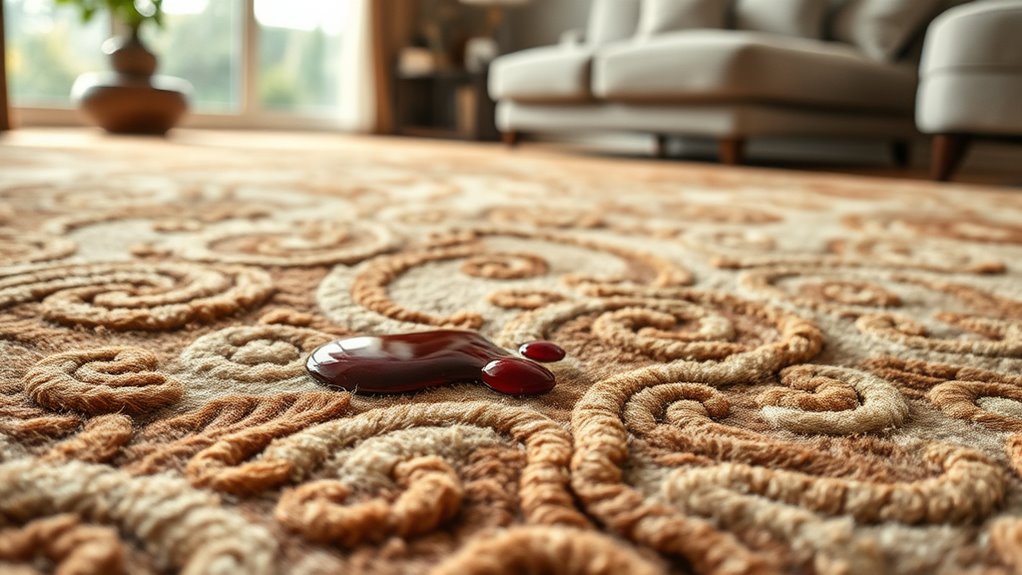
To keep your wool rug naturally resistant to stains, maintaining its lanolin coating and following proper cleaning practices is vital. Regular vacuuming removes dirt and debris that can break down lanolin, preserving its protective properties. Address spills immediately by blotting gently with a clean, damp cloth—avoid rubbing, which can embed stains. Use mild, wool-safe cleaners when necessary; harsh chemicals can strip lanolin and diminish stain resistance. Avoid excessive moisture, as water can damage wool fibers and reduce lanolin’s effectiveness. Consider periodic professional cleaning to deep-clean without harming the fibers or lanolin layer. Protect high-traffic areas with rugs or pads to minimize wear. Additionally, understanding AI’s role in healthcare highlights the importance of integrating innovative solutions for maintenance and preservation. Proper maintenance ensures your wool rug retains its natural stain resistance, keeping it looking beautiful and protected over time.
Frequently Asked Questions
How Does Lanolin Affect Wool Rug Allergen Levels?
You might wonder how lanolin impacts allergen levels in wool rugs. Lanolin, a natural oil in wool, creates a protective barrier that repels dust, dirt, and other allergens. This helps keep your rug cleaner and reduces allergen buildup over time. As a result, rugs treated with lanolin tend to be less prone to trapping allergens, making them a better choice for allergy sufferers.
Is Lanolin’S Stain Resistance Affected by Cleaning Products?
You wonder if cleaning products impact lanolin’s stain resistance. Generally, harsh chemicals can strip or weaken lanolin’s natural oils, reducing its ability to repel stains. To preserve this property, use gentle, wool-safe cleaners and avoid harsh detergents. Regular, proper cleaning maintains lanolin’s protective layer, keeping your wool rug more resistant to stains. Always check product labels and opt for cleaners designed specifically for wool to guarantee the best stain resistance.
Can Lanolin’S Properties Diminish Over Time or With Wear?
Imagine your favorite wool rug as a loyal friend, weathering seasons with grace. Over time, you might wonder if its protective qualities fade. The good news is, lanolin’s natural properties don’t diminish easily. With gentle care, its stain resistance remains strong. Like a trusted companion, your wool rug can continue to guard against spills and stains, maintaining its beauty and resilience for years to come.
Are There Environmental Impacts of Harvesting Lanolin for Wool Rugs?
You might wonder if harvesting lanolin affects the environment. When farmers collect lanolin from sheep wool, it’s a natural byproduct, so they don’t need extra resources or cause significant harm. However, large-scale sheep farming can impact land use, water, and greenhouse gases. Sustainable practices and responsible farming can minimize these environmental impacts, making lanolin a more eco-friendly option for wool rugs.
How Does Lanolin Influence Wool Rug Fire Resistance Properties?
Lanolin naturally enhances wool’s fire resistance by creating a slight, protective barrier on the fibers. This barrier helps slow down ignition and reduces flame spread, making wool rugs less flammable. When you use wool rugs treated with lanolin, you’re benefiting from this inherent fire-resistant property. The lanolin’s waxy composition acts as a natural fire retardant, providing added safety without needing chemical treatments, making your space safer.
Conclusion
Don’t let worries about stains hold you back from choosing a wool rug. Lanolin’s natural protective layer keeps spills at bay, making your space easier to maintain and more inviting. Yes, it might seem delicate, but its resilience proves otherwise. Embrace the beauty and durability of wool rugs, knowing their natural lanolin offers ongoing stain resistance. With proper care, you’ll enjoy their timeless charm and peace of mind for years to come.



